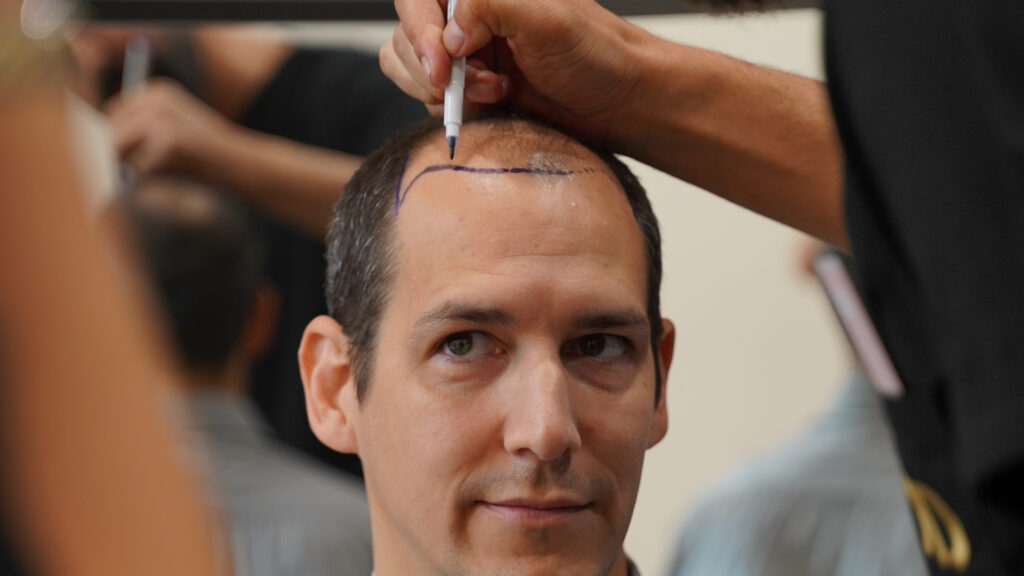When a man experiences hair loss, it is important to understand how the baldness will progress. Dermatologists and hair specialists use a scale of alopecia known as the Norwood-Hamilton scale to assess the stage of hair loss and determine the best solutions to address it. However, it is essential to note that the Norwood-Hamilton scale only applies to male baldness. For women experiencing hair loss, specialists use the Ludwig scale. The Ludwig scale is similar to the Norwood-Hamilton scale and is used to determine the progression of female baldness.

What is the Norwood-Hamilton scale?
The Norwood-Hamilton scale, also known as the Hamilton-Norwood scale or the Norwood scale, is a graduation system for male alopecia that measures hair loss’s different stages and evolution. This schematic scale was created in the 1950s by James B. Hamilton, an American doctor, a specialist in human anatomy and a researcher in male hormones. It was then updated in the 1970s by another American doctor, O’tar Norwood, integrating medical research progress. Both simple and precise for diagnosing androgenetic alopecia, it is now used worldwide by specialists in male pattern baldness and hair transplantation. It has seven stages, from a regular and complete hair cover to total baldness.

The 7 stages of the Norwood-Hamilton scale
The seven stages of the Norwood-Hamilton scale are used to measure the extent of a patient’s androgenetic alopecia (the most common type of alopecia in men) and its future evolution. This allows the surgeon to determine the best treatment to stop hair loss. This scale is valid for all hair types, for Indo-European hair as well as for curly hair.

Stage 1: the control stage
The initial stage of baldness control is correlated with the hair condition during adolescence. At this stage, baldness is completely absent. While some men may have a high hairline and others may have a lower hairline on the forehead, this does not necessarily indicate impending baldness.

Stage 2: slight baldness of the frontal area
The second stage of the Norwood scale is defined by incipient baldness of the frontal hairline, particularly on the temporal gulfs. This stage corresponds to a mature hairline, with the vast majority of adult men having their hair at this level, with a 1 to 2 cm recession of the hairline, while very slight hair loss can also sometimes be seen at the vertex, the top of the skull. At this stage, no doctor advises to undertake a hair transplant: while the hair could continue to fall out, it will be difficult, later on, to connect the initially transplanted area to the remaining hair. Some medications can be prescribed, but their side effects can be dangerous, and their results are doubtful. In addition, if the treatment is stopped, hair loss will resume. Take better care of your hair with treatments based on natural products, such as argan oil or rosemary essential oil. Even if these products can only slow down the advance of androgenetic alopecia, but not stop it.

Stage 3: significant balding
Stage 3 is diagnosed when significant balding appears in the centre of the skull (vertex) and/or when the frontal line retreats towards the top of the skull, with apparent hair loss on the temporal gulfs. This is the most common type of baldness in men. At this stage, a PRP treatment, as well as a laser treatment, can be considered to slow down the baldness and preserve the remaining hair. This is also the first stage on the Norwood scale where a first partial hair transplant can be considered.
Stage 3 Vertex: the centre of your skull is receding
This stage is reached when the vertex, in the centre of the top of the head, is affected by visible hair loss, but the frontal line remains identical to stage 2, and the back remains full.
Stage 3 A: Your frontal line recedes to the back
When the hairline recedes substantially, clearing the frontal temporal gulfs, and the scalp in this area becomes bare, stage 3A of the Norwood-Hamilton scale is reached. At this stage, a PRP treatment and a laser treatment can be considered to slow down the baldness and preserve the remaining hair.

Stage 4: severe hair loss
At this stage, hair loss beyond the hairline becomes significant, with almost no hair left on the upper part of the head, except for a band connecting the two sides. The hair is still present on the temples, although it may move slightly upwards. And each side of the skull is connected by a thin strip of hair.

Stage 5: very advanced baldness (but you still have hair)
In stage 5, the baldness is very advanced, but hair is still on the sides and back. A thin bridge of hair remains on the crown, connecting the two sides.

Stage 6: the monk’s baldness
At stage six of baldness progression, hair loss on the crown of the head is complete, extending from the hairline to the vertex. A band of hair remains, which connects the sides and back of the skull, and may be denser. The occiput is typically the most resistant to baldness. It is often utilised as a donor area for hair transplants, where hair follicles are extracted and transplanted to the recipient area.

Stage 7: The most advanced androgenetic alopecia
This is the most advanced stage of male pattern baldness. The top of the head is completely bald, but some hair is still thinner and of varying density at the back and on the sides.
At what stage is it possible to undertake a hair transplant?
All hair transplant specialists will advise you: if you wish to undertake a hair transplant, do not wait until stage 7. However, it is too early, at stage 3, to opt for a hair transplant: your baldness may spread, and a second transplant could be necessary. Ideally, hair transplantation should be considered from stage 4 onwards, with the restoration of the vertex and/or the frontal line. However, it may be necessary to proceed a few years later, to a second transplant, depending on the progression of baldness. An FUE hair transplant will be strongly recommended from stage 5 or 6 to bring the hair coverage back to stage 3 or 4. When the level of hair coverage reaches stage 7, a hair transplant is possible. Still, it requires a more massive transplant of follicles and, therefore, a longer surgical procedure carried out by an outstanding surgeon to offer a natural density to your hair. In any case, a hair transplant is successful if you strictly follow all the recommendations and post-operative care your hair surgeon prescribes.
Before and after hair transplants at Body Expert










45927 vues
0 commentaires
1






Il n'y a pas de commentaires pour le moment.